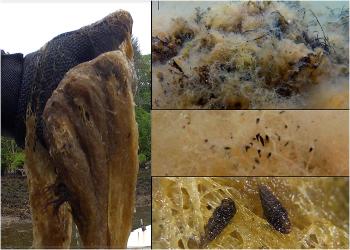Is blanket weed (filamentous algae) associated with nutrient-rich discharges smothering maerl beds within the Wester Ross MPA?
Posted: Monday 6 June, 2022 @ 14:46:00

The Wester Ross Marine Protected Area [MPA] was designated in 2014 by the Scottish Government to protect seabed habitats. Important priority marine features within the MPA include maerl habitats which are found in Loch Ewe, Gruinard Bay and around the Summer Isles.
Maerl is formed by coralline algae which grow very slowly on the seabed where there is sufficient sunlight. Maerl beds support high biodiversity and contribute to carbon sequestration and storage in the seas around Scotland.
A poster providing more information about maerl can be found on this website here or by clicking on the link below: https://www.wrft.org.uk/files/18%20Maerl%20poster%20(A1L)%20opt.pdf .
The Wester Ross MPA conservation aim for maerl is for recovery. Maerl habitats can be damaged by scallop dredging and other human activities.
In May 2019, WRFT found filamentous algae growing over both the maerl beds to the west of Inverewe Gardens in Loch Ewe and on sea grass beds in Loch Ewe and Gruinard Bay (see SWRFT Review Sept 2020, p54). In May 2022, the WRFT biologist led a survey of the shore and shallow subtidal areas by Inverewe in support of the Underwater Garden exhibition at NTS Inverewe Gardens. Below the low tide line, the seabed was found to be mostly covered by a thick blanket of filamentous algae, supporting high numbers of the snail ?Bittium reticulatum.
‘Blanket weed’ reduces the amount of sunlight reaching seaweeds including maerl beneath. Rapidly growing blanket weed can be an indicator of nutrient enrichment, associated with anthropogenic discharges, including discharges from sewage treatment and from salmon farms.
Are cumulative nutrient discharges associated with salmon farming into coastal waters within the west of Scotland already too high?
In 2018, a review of the environmental impacts of salmon farming prepared for the Scottish Parliament enquiry (SAMS Research Services, 2018) considered eutrophication and advised that
‘Significant enrichment of lochs and regional seas by salmon farm nutrients could lead to enhanced growth of phytoplankton, and undesirable disturbance to the balance of organisms and to water quality. . . ’
‘. . . Models predict, and limited observations confirm, increased nutrients in lochs from salmon farming. In some lochs and voes the increase may be substantial during summer. Calculations suggest that this could also be happening in coastal waters such as the Minch. There is, however, no evidence of increased phytoplankton growth or production due to these nutrients. The 'balance of organisms' in the phytoplankton is changing in at least one loch used for farming, but this is likely due to causes other than nutrients from salmon.
In most cases, data allowing an assessment in the changes in plankton communities over time are not available.’
Contrary to the ‘no evidence’ statement in the above quotation, does the occurrence of more frequently occurring blanket weed on the seabed within the Wester Ross MPA [adjoining the Minch] suggest that nutrient levels or imbalances may already be adversely affecting the recovery of maerl within the MPA?
‘Far-field effects’ of aquaculture remain poorly understood (Oh et al, 2019; Rector et al, 2022). The Scottish Environment Protection Agency [SEPA] may therefore not be in a position to safely grant CAR licenses for additional substantial discharges of nutrient-rich wastes from aquaculture into the Wester Ross MPA because it does not have reliable information upon which to assess whether or not future discharges will adversely affect the recovery of maerl.
The status of maerl beds and other seabed habitats across much of the Wester Ross MPA is currently poorly known. Prior to granting of licenses for substantial additional nutrient-rich discharges into the Wester Ross MPA (for example a CAR license for proposed new 1100 tonne salmon farm by Horse Island within the Wester Ross MPA), Nature Scot and SEPA working together need to publish evidence that the recovery of maerl, the most important protected feature for which the Wester Ross MPA was designated, is indeed occurring. This may require additional surveys of maerl habitats to validate hydrographic and nutrient-discharge modelling.
Snorkelers, divers, and coastal community groups using drop-down cameras can help by reporting observations of blanket weed (filamentous algae) on the seabed. To what extent are maerl beds within the Wester Ross MPA and other areas affected?
Please record the date & time, location, water depth (m) and provide an estimate of the thickness of the filamentous algae and % of seabed covered. Underwater photographs or video (with an indicator of scale) can be useful. This information may be useful for mapping out the distribution of the blanket weed.
*Similar observations of blanket weed, blocking light from maerl and sea grass, have recently been reported in the south Skye sea lochs and as far south as Arran (pers. comm.). Do these observations warrant investigation and explanation by the Scottish Government prior to granting of consents for further increases in nutrient discharges from open cage salmon farms?
Thank you to NTS Inverewe Gardens and all the helpers with the survey on 16th May 2022.
For further information, please contact WRFT info@wrft.org.uk .
References:
Humphries, A (2019) Tasman Peninsula residents fear fish pens to blame for slimy algae at bay near Port Arthur https://www.abc.net.au/news/2019-12-15/tasman-peninsula-bays-filled-with-algae-near-tassal-salmon-pens/11796332
Oh, E et al (2015) Broad-scale impacts of salmon farms on temperate macroalgal assemblages on rocky reefs. Mar. Pollut. Bull. (2015) https://www.sciencedirect.com/science/article/abs/pii/S0025326X15004166?via%3Dihub
Rector, ME et al (2021) Environmental indicators in aquaculture: a systematic review. Reviews in Aquaculture. https://onlinelibrary.wiley.com/doi/epdf/10.1111/raq.12590
SAMS Research Services (2018) Review of the environmental impacts of salmon farming in Scotland. Executive summary and main report. The Scottish Parliament, January 2018 https://archive2021.parliament.scot/S5_Environment/General%20Documents/20180125_SAMS_Review_of_Environmental_Impact_of_Salmon_Farming_-_Report.pdf